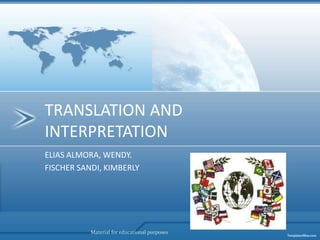
Translation and Interpretation
- 1. TRANSLATION AND INTERPRETATION ELIAS ALMORA, WENDY. FISCHER SANDI, KIMBERLY Material for educational purposes
- 2. What is translation A written communication in a second language having the same meaning as the written communication in a first language (Princeton edu) Material for educational purposes
- 3. Basis of translation Ferdinand Saussure: Language is a structure that achieves meaning through oppositions. Conventional meaning “ Their most exact meaning is that they are what the other words are not.” 1793 Sign and referent Material for educational purposes
- 4. perception community speech hypothesis one to one correspondences not independent of a language community attributed sense ( fleuve- riviere) Linguistic Determinism: thoughts and perceptions are determined by the categories of their language Material for educational purposes
- 5. Translator’s Role “An excellent translation reads like a piece originally written in the target language, sentence structure, linkages and discourse, are entirely appropriate to the target language.” U.K. Linguistics Association Material for educational purposes
- 6. Translation methods Word for word Translation Literal translation: Grammatical constructions are converted but lexical items are out of context Faithful translation: contextual meaning Semantic translation: Aesthetic meaning Communicative translation Idiomatic translation: colloquialisms Free translation: paraphrasing Adaptation: plays, SL to TL culture Material for educational purposes
- 7. INTERPRETATION Interpretation is to facilitate oral or sign-language communication. An interpreter is a person who converts a thought or expression in a source language into an expression with a comparable meaning in a target language in "real time". Material for educational purposes
- 8. INTERPRETATION TYPES Simultaneous: In simultaneous interpretation (SI), the interpreter renders the message in the target-language as quickly as he or she can formulate it from the source language, while the source-language speaker continuously speaks. Consecutive: In consecutive interpreting (CI), the interpreter speaks after the source-language speaker has finished speaking. The speech is divided into segments, and the interpreter sits or stands beside the source-language speaker, listening and taking notes as the speaker progresses through the message. Material for educational purposes
- 9. INTERPRETATION TYPES Whispered: In whispered interpreting, the interpreter sits or stands next to the small target-language audience whilst whispering a simultaneous interpretation of the matter to hand; this method requires no equipment, but may be done via a microphone and headphones if the participants prefer. Material for educational purposes
- 10. INTERPRETATION TYPES Relay: Relay interpreting is usually used when there are several target languages. A source-language interpreter interprets the text to a language common to every interpreter, who then render the message to their respective target languages. Liaison: Liaison interpreting involves relaying what is spoken to one, between two, or among many people. This can be done after a short speech, or consecutively, sentence-by-sentence Material for educational purposes
- 11. MODALITIES On-site: Also called "in-person interpreting," this delivery method requires the interpreter to be physically present in order for the interpretation to take place. Telephone: Also referred to as "over-the-phone interpreting," this modality enables the interpreter to deliver interpretation via telephone. The interpreter is added to a conference call. Video: Interpretation services via Video Remote Interpreting (VRI) or a Video Relay Service (VRS) are useful where one of the parties is deaf, hard-of-hearing or speech-impaired (mute). http://www.youtube.com/watch?v=ZIG-YKwy_Zk&feature=related Material for educational purposes
- 12. Material for educational purposes